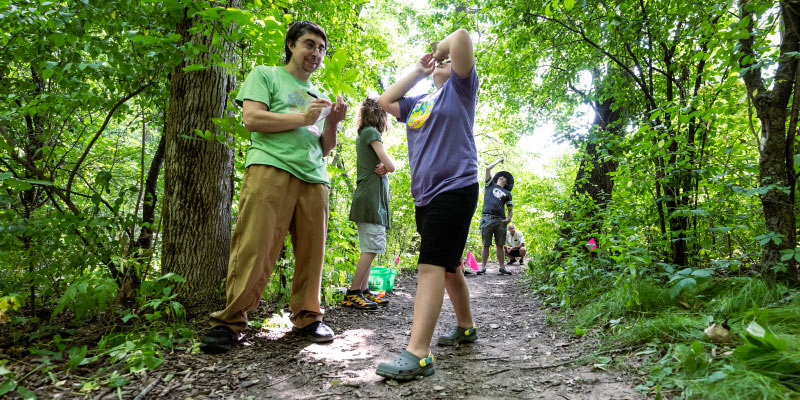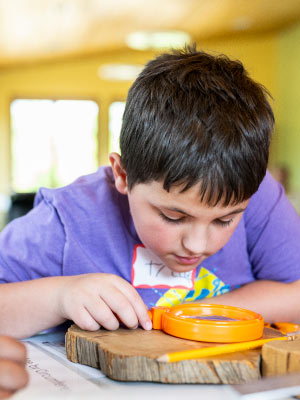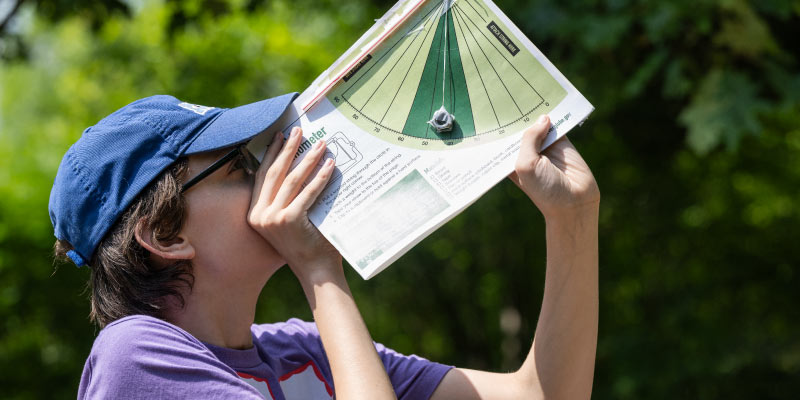
Ship’s log, stardate 101149.99.
Our exploration crew has safely landed on the alien planet called “Earth.” We’re here on a peaceful mission: to gather observations on the planet’s land cover. Fortunately, this planet has the same air composition and gravitational force as our home planet, our leader, Greedo, tells us. Exiting the ship, we walk a dry, dusty path to a shaded forest. Greedo — with help from his second in command, Vader — teach the crew’s youngest members, Relyt and Alienname, how to collect observations. They determine that the forest has 100 percent canopy cover, with trees measuring between 19 and 22 feet high.
Okay … so maybe there wasn’t an alien invasion on Earth recently. But there was a place where aliens were real and possibilities were endless. The alien spaceship is actually the Welty Environmental Center in Beloit, Wisconsin, and its leader, Greedo, is none other than Michael Notaro, director of the Nelson Institute’s Center for Climatic Research. We’re at the Sky’s the Limit STEM Camp, a summer day-camp for autistic youth.

Created by Notaro in the summer of 2022, the camp offers hands-on, exploratory learning experiences for free, thanks to a grant from the National Science Foundation’s GEOPaths program. Notaro’s motivation to create safe and meaningful learning opportunities for neurodivergent kids came from his son, Hayden, who is autistic. “I think a lot of people see autism as a disorder or a disease you try to fix. That’s not the case,” he says. “Neurodiversity is something we want to support.” Plus, when it comes to neurodiversity in STEM, support — and representation — are severely lacking. While autistic students tend to have a higher interest in STEM fields than neurotypical students, Notaro explains, fewer continue on to STEM degrees or jobs. With the Sky’s the Limit, Notaro is working to fix that disparity.
This summer’s camp lasted six weeks, with a different session held each Friday afternoon. Parents drive from as far north as Madison and as far south as Chicago to give their kids a chance to drive a remote-controlled TerraRover, fly drones, and measure water quality in the nearby Goose Creek — just some of this year’s session topics. The camp’s programming uses NASA’s GLOBE (Global Learning and Observations to Benefit the Environment) Program learning protocols as a guide, each day centering on a specific protocol: atmosphere, biosphere, hydrosphere, and pedosphere. This year, the camp added a second branch — Nature’s Navigators — held at the Upham Woods Learning Center and facilitated by the UW–Madison Division of Extension.
It’s July 21, the last day of camp, and today’s theme is the biosphere — or all parts of the earth where life exists. The classroom’s own biosphere is remarkably diverse. Buckets of leaves, sand, and grasses line the long table at the front of the room. By the window, a mesh hamper is alive with monarch butterflies. As campers and their parents arrive, everyone gravitates to something different. Flynn, a 12- (almost 13) year-old from Janesville makes a beeline for the butterflies. Tyler, who came with his grandfather, browses a table filled with games and fidget toys before selecting an Angry Birds building-block game. Several campers walk in and head straight to an oversized sticky note which, as always, has the day’s activities written out in various colors.
Around 1 p.m., Notaro gets camp started — the same way he does each time. Standing in front of the group, he holds several sheets of paper, each printed with a different affirmation. As he holds up each sign, he reads it aloud:
“Neurodivergence is wonderful.”
“Your feelings are important to us.”
“If any camp activity makes you feel uncomfortable, you can choose not to do it and camp helpers will offer alternatives.”
“The best science is done by a diverse set of scientists from different neurotypes, races, and genders.”
“While science textbooks are useful, science is best learned hands-on while following the scientific method.”
And with that, the exploration begins.

A More Perfect Classroom
Imagine a classroom where you can move around when you need to or get up and look closer at something if you want to — and the teacher doesn’t assume you’re being naughty. Imagine a classroom where the operating assumption is that all pupils are listening, engaged, and learning, even if they aren’t all sitting upright in their chairs, scribbling notes, eyes glued to the chalkboard. This is the kind of classroom Notaro creates at The Sky’s the Limit.
The first activity of the day is an investigation of leaf pigments. After heading outside to collect a sample of different colored leaves, the campers sit at long tables and, with mortars and pestles, grind the leaves up into small fragments. There’s a camp helper at each table: many of whom are Welty staff members. Once the leaves are crushed up, the campers and helpers put the fragments into a beaker filled with water, stir it around, then pour it into a large mason jar.
Mairead, who just graduated high school, takes her time, deliberately separating her leaf from its vein before, piece by piece, dropping each crumb into the water. This is Mairead’s first summer with The Sky’s the Limit. “It’s a nice experience,” says Mairead’s mom, Margaret, who makes the drive in from their home in Rockford, Illinois. “They don’t always get a lot of time to be around other [autistic] kids that are like them.”
As Mairead finishes adding her leaves to the water, Tyler is watching Notaro complete the final step: pouring alcohol over the watery leaves. “You have to wait a while now,” Helper Raven tells him. “Fine,” Tyler sighs, his nose pressed against the jar. Holden (today going by Krang, the name of his favorite Ninja Turtle), checks out everyone else’s jars while Helper Rebecca finishes his. We’re all learning, but it looks different for everyone. In Notaro’s biosphere, campers aren’t “allowed” to be themselves — they just are.
A Thriving Ecosystem
The day continues with a split into three small-group activities: two campers to a group, led by one or two camp helpers. The campers get to choose their own adventure to start, and Tyler and Flynn head over to Helper Raven, who’s stationed at a table up front that’s littered with tree rings, twigs, and microscopes. Here, they’re learning to calculate a tree’s age by both counting rings and by measuring the circumference. Tyler picks up a giant, orange magnifying glass and inspects a tree ring. “Think I can count every single one?” he dares himself. Helper Raven eggs him on: “I don’t know … wanna try?” “Yeah!” Tyler exclaims” “One, two, three …” he gets to 13. “Never mind.”
After a brief interlude for ice cream (a hit for both campers and parents alike), it’s time to switch groups. Tyler and Flynn head over to their next activity, led by Notaro and Helper Aaron, the Welty Environmental Center’s program director. Notaro delivers some shocking news: “As of this moment, from this point on, you’re no longer human. You are now an alien,” he says. “I am an alien?!” Flynn exclaims and starts making alien sounds. “This is our mothership. We landed here, and we’re going to explore this planet Earth and its vegetation,” Notaro continues.
With renewed energy, Tyler (Relyt) and Flynn (Alienname) follow Notaro (Greedo) and Helper Aaron (Vader) out of the building to the start of a wooded hiking trail. Using a densiometer (a device to measure forest density) fashioned from a toilet paper tube and dental floss and a clinometer (an instrument to estimate tree height) made from a straw, a string, and a washer, Notaro guides Tyler and Flynn in measuring the forest’s attributes using GLOBE’s Modified UNESCO Classification Guide — or MUC.
As Tyler takes observations of the canopy cover, his grandfather Richard, who’s been coming with him to camp, stands back and takes observations of his own. This is Tyler’s first year at The Sky’s the Limit, and for Richard, it’s been a unique experience. “I get to see him engaged and interacting with adults and other children. I don’t really get to see that at school,” he reflects. “There’s parent-teacher day, but that’s a different thing. I don’t get to observe him in the classroom. This is the closest thing I have to see how he interacts with other children and adults.”
Back inside, Tyler and Flynn head to their final station, “Ecosystem in a Jar,” led by Helpers Justin and Candis. As the name suggests, in this activity, the campers create their own living worlds in large mason jars. First, they add a layer of river rock, scoop in some fresh dirt, sprinkle a layer of chia seeds, and top it with tree moss and water. “What do we know about ecosystems? What’s an ecosystem?” Helper Justin asks as the activity starts. “It’s a thing that lives,” Flynn responds with confidence, his eyes transfixed on the jar’s lid that makes a satisfying “pop” each time he presses and releases. Among the campers, Flynn is a veteran: he was part of the inaugural camp cohort. “We made it every week last year, and we only missed one week this year,” says Flynn’s dad, Jason. The environment isn’t Flynn’s favorite topic — he’s much more into computers (he once built the Windows operating system into a MacBook) — but opportunities for hands-on learning tailored to neurodivergent youth are few and far between … and they usually cost a lot of money. And for Jason, the camp is just as beneficial to the parents as it is to the kids. “It’s good to talk with other parents who can relate to you,” he says. “There’s a lot of networking and sharing ideas.”

Forest for the Trees
As the day (and the campers’ energy) winds down, Notaro calls the group together for one last activity. Helper Aaron takes over, leading the campers and helpers through an interactive game called the “Forest Succession Game.” Each participant sits on a plastic square, where they have to stay throughout the game. Helper Aaron opens a small container of confetti made from large pieces of construction paper and dumps it over the campers, eliciting delighted squeals and giggles. “I’m gonna give you 20 seconds to get as many resources as you can,” Helper Aaron instructs. “Ready … go!” Seated on their squares, the campers reach as far as they can and scoop up piles of confetti. “In order to survive as a tree,” Helper Aaron says when the 20 seconds are up, “this year was very, very dry. You need to have at least six blue [pieces] to survive.” The room erupts into out-loud counting. Helper Justin is the only tree to not get six blues, so he has to throw his resources back into the forest and exit the game. The sequence repeats, this time focusing on yellow confetti — sunlight.
By throwing, gathering, and counting confetti, they learn how forests grow and evolve — and how it’s affected by changing resources. It’s a simple lesson, really: if you have the right resources, you’ll thrive. Share the resources, and you’ll help others to thrive. With The Sky’s the Limit, Notaro takes this lesson one step further: different trees need different resources. One wouldn’t consider a singular method for managing the growth of a large, diverse forest, if it supports one type of tree but not others. Notaro sees the forest for the trees. And what happens when each type of tree is given the unique resources that it needs? Diversity thrives, and the forest grows larger and stronger.
“The best science is done by a diverse set of scientists from different neurotypes, races, and genders.”
“Neurodivergence is wonderful.”